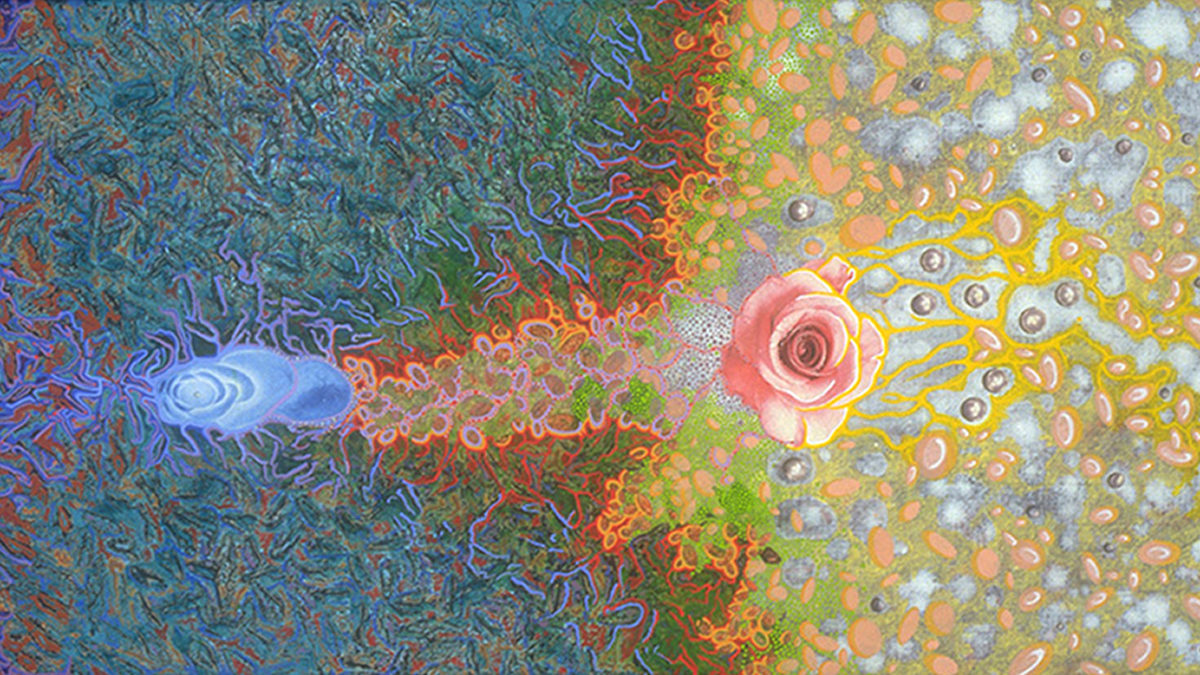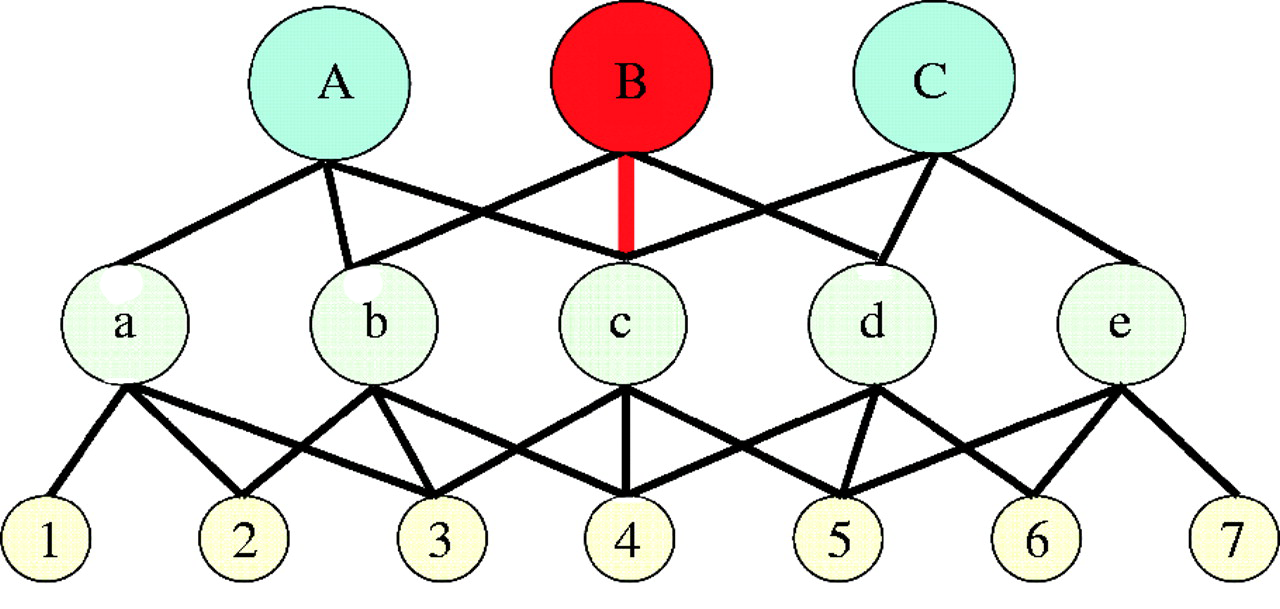a speculative inquiry into the nature of consciousness

Materialism and consciousness
At the very core of mainstream science is the assumption that the universe is entirely materialistic. Consciousness emerges as a function of the electrial activity of a brain, when a brain evolves to a sufficient level of complexity. There is no meaning or purpose to life, apart from the imaginings of humans and their religions – there is only the more or less random evolution of material configurations. Richard Dawkins is the most vocal and prolific expounder of this materialist perspective, a perspective that mainstream scientists subscribe to without ever thinking to question it.
There is another model of consciousness that says consciousness is not embodied in the brain. Rather our minds exist apart from our brains, and outside the domain of physics. The function of the brain, in this model, is to serve as a kind of interface module, enabling the mind to interact with the five senses and the body. This we can call the metaphysical model of consciousness.
Evidence for the metaphysical model comes in the form of ‘unexplainable’ experiences. An unconscious patient, registering no electrical brain activity at all during a critical operation, reports later that he observed the operation from the ceiling, and is able to describe specific things that happened during the operation. Or someone has a near-death experience, and reports certain kinds of experiences that have also been reported in other near-death cases.
There are a great many reliable reports of ‘unexplainable’ experiences of various kinds, all of which indicate that mind exists apart from brain functioning, and exhibits properties that violate the rules of materialist science. Dean Radin is one of the best-known researchers in this area, and his book, The Conscious Universe, gives a good overview of the research and thinking in this area. I don’t necessarily go along with all of his thinking, but the evidence he and others gather can be used quite independently of their various conclusions.
For the materialist model, on the other hand, there isn’t much in the way of evidence. It’s merely an assumption to say that consciousness is an electrical property of the brain, and it’s an assumption that seems to be contradicted by considerable evidence of various kinds. The fact that certain parts of the brain ‘light up’ electrically, when a certain kind of activity is underway, is quite consistent with the notion that the brain is an interface module, called selectively into play when our mind wants to interact with the physical world in some particular way.
I leave it to you the reader to decide if you want to seriously consider a metaphysical model of consciousness. I’ve alluded to evidence, but I have no intention of trying to prove here that the mind is metaphysical. If you want to delve into that question, I recommend looking at the work of people like Radin, Rupert Sheldrake, and many others, who are doing serious research in the field of consciousness. My own view is that the metaphysical model is our best working hypothesis for consciousness, based on all the evidence I’ve seen so far.
The nature of this inquiry
In this inquiry, I’ll be starting with the assumption that our minds are metaphysical, and I’ll be teasing out what implications seem to follow from that assumption. I won’t be bringing in any additional results from the work of Radin, Sheldrake, or anyone else. Indeed, my work may serve to corroborate their work – by reaching the same conclusions from a different direction.
What I’ve found is that quite a bit can be inferred from just this one assumption. Opening the door to the metaphysical is like going down the rabbit hole in Alice in Wonderland. A whole new world opens up, with its own structure and its own dynamics. As we explore the depths of the rabbit hole, I’ll be seeking to organize what we find into a coherent model, presented in blue text. I’ll begin the construction of the model with a definition:
Consciousness exists in a domain that is separate from the physical domain. Mind is a psychic field in the domain of consciousness. This psychic field is in resonance with the brain, and can influence the electromagnetic field of the brain. In this way the mind is able to orchestrate the activity of the brain, and thereby direct the activity of the person. Purpose, will, meaning, and experiencing are properties of mind, and have no existence in the physical domain.
In this next section we’ll be exploring the following question: if our human minds are metaphysical, what does that imply about other species, and about life in general?
Consciousness and life
Anyone who has ever had a pet dog has surely experienced that their dog’s consciousness is akin to their own. As regards things like ‘appreciating companionship’, ‘wanting to please’, ‘feeling guilty’, or ‘loyalty to a friend’, their consciousness seems to be of the same stuff as our own. In any case, it makes no sense in terms of evolutionary process to think that a metaphysical mind could be unique to the human species. To assume that mind first came in with humans would imply that other animals have a more advanced brain than ours, one that can simulate the functions that we rely on consciousness for.
If humans have a metaphysical mind, then from an evolutionary perspective we must accept that all animals have a metaphysical mind. There isn’t anywhere we could mark a spot on the evolutionary tree of animals, and say ‘mind came in here’. If it was ‘here’ it must have also been ‘there’ – one step back in evolution – or the preceding species couldn’t have functioned.
So a mind was there at the very beginning, when the first animal life form wiggled about in some primordial sea. And that mind was connected to the primitive nervous system of that life form. If we go back one step in evolution, a more primitive version of the nervous system must have been already in place, and the functioning of that system would require that a mind be already in place as well.
Thus mind was there, as part of life, even before the first animal emerged. Mind must also have been there even earlier, at each evolutionary step leading up to the species just before wiggling. Again, there’s nowhere on the tree of evolution where you can say ‘mind came in here’ – apart from the very root of the tree – the very beginning of life itself.
Mind is inherent to life – life itself is a manifestation of consciousness in the physical domain. Every organism has two parts: a mind in the consciousness domain, and an embodiment in the physical domain.
The coevolution of species and mind
I take it as self-evident that the body and mind must be in balance with one another. There must be a strong degree of congruence between the scope and complexity of the psychic field, and the scope and complexity of the organism and its behaviors. A more complex brain, for example, implies a more complex mind. It would make no sense for a butterfly to have a part of its mind concerned with mathematical puzzles.
Mind has coevolved with species. As species have grown in complexity and scope, their psychic fields have grown similarly in complexity and scope. The process of species evolution has enabled mind evolution
The co-development of organism and mind
If every organism has a mind, then that mind, that psychic field, must be present with the very first cell of that organism, the first cell that is part of ‘baby’ rather than part of ‘mommy’. Where else could we draw the line, and say ‘the mind comes in here’? The embodiment of the mind, at the beginning, is a single embryonic cell, a fertilized egg or seed.
I take it as self-evident that the function of the mind is always, even at the beginning, to direct the activity of its embodiment. That is to say, the business of the mind, as an embryo develops, is to manage the development of the embryo. DNA manages protein production, but it is mind that manages the development of the morphology of the organism.
mor·phol·o·gy noun
: the form and structure of a plant or animal or any of its parts
Merriam Webster online dictionary
Sheldrake argues that “morphogenic fields” (form-generating fields) must have a role in the development of organism morphology, based on the observation that DNA does not contain enough information to determine morphology. My line of argument leads me to the same conclusion.
The mind of an embryo is acting as a morphogenic field – it is a psychic field engaged in morphology development – by means of its ability to interact with matter electrically and magnetically. This is the role of mind in the early stages of organism development.
Even though the early role of the mind is somewhat humble, the mind must be appropriate to the species. In the early stages the mind must be creating an embryo that is appropriate to the species, and in the later stages the mind must have the capacity and complexity appropriate to the species. That is to say, the embryo’s psychic field must already have the inherent capacity and complexity of an adult psychic field. If it’s a human embryo, the early mind must already have the potential capacity to appreciate music and to use complex language.
We can think of a developing organism as being a sequence of different organisms. An egg is an organism that develops into an embryo. An embryo is an organism that develops into a fetus, a fetus into a baby, a baby into a toddler, etc. In a very real sense, each organism in this sequence is of a different species. Each species in the sequence brings in a new dimension of complexity, lacked by the previous species. What does this imply, as regards what’s happening with the mind of the organism, as the organism advances up the tree of these ‘species’?
Earlier I took it as self-evident that the mind and body of an organism must be in balance with one another – the scope and complexity of the mind must be in balance with the scope and complexity of the behaviors of the organism. Here I take it as self-evident that the mind – at each stage of organism development – must be in balance with that stage of the organism. In other words, the complexity of the mind must increase as the organism develops.
This leaves us with a bit of a conundrum. On the one hand, the mind of an embryo must have the inherent complexity of an adult of the species, yet on the other hand the mind of an embryo must have far less complexity than that, in order to be in balance with the embryo-as-organism. What this seems to imply is that most of the complexity of the mind is dormant at the beginning; we could say it is sleeping. At the embryonic stage, the part of the mind that is awake is only that part which is concerned with the development of the embryo.
A mind’s psychic field consists of many subfields, each of which has the capacity to be in resonance with some aspect of organism functioning. As the organism develops, these subfields remain asleep until they are needed – until the organism develops to the stage where there is something for a given subfield to resonate with.
It’s as if the various subfields, in their sleep, are sending out test signals. If an echo comes back, then resonance has occurred, and the subfield wakes up. Otherwise it continues sleeping. Whatever the mechanism, it seems clear that the development of the organism is the driver process, the process that somehow leads to the awakening of psychic subfields when their time comes.
As we move higher up in the tree of actual species, say from early mammals to humans, an increasing proportion of psychic subfields are related to cognitive functioning. As regards motor functions, there is little difference between the relevant psychic subfields of a human or of a gazelle. Both are of about the same order of complexity. But as regards subfields related to cognitive functioning – such as those subfields that resonate with imagination, stories, or scientific pursuits – we see a significant expansion of mind complexity, if we compare humans with other species.
From our intellect-intensive human perspective, it is easy to think of mind functioning as being mostly related to cognitive functioning. It is those functions, after all, that we pay conscious attention to. We are not aware of the activity of those psychic subfields that resonate with the body, at the level of organs and cells. Those subfields are operating on habit, and we pay no attention to them.
Attention and learning
When we were learning to walk, we were paying close attention to every little movement of our bodies, to keep from falling. As adults walking has become a habit, and we normally pay no attention to how we’re doing it. If we encounter a challenging new walking context, however, we need to pay attention to how we’re walking, or else we’re likely to fall down. Anyone who walks for the first time on a slippery surface wearing flip-flops, for example, soon finds that they need to find a new way of walking, in order to keep from slipping.
In terms of fields, this means that the psychic subfields involved in walking need to be trained, with the help of attention, in order to function successfully. Once trained, the subfields can function without the help of attention, but only within the scope of circumstances for which they’ve been trained. In order to expand the scope to new circumstances, attention must again be involved.
We can think of our walking-related subfields as being programmable robots, each able to perform a range of functions, but which have no programs loaded when they first wake up. We can think of attention as being the human programmer of the robots.
In the process of learning, the programmer takes over manual control of the robots involved, and figures out how to perform some new task using the robots’ capabilities. The steps that the programmer goes through become scripts for the robots, which they follow whenever dealing with a similar situation in the future. When a situation arises that the robots can’t handle, the programmer notices, and returns to figure out how to deal with the situation, updating the scripts in the process.
I’ve used walking as an example, but the same considerations apply to everything we learn. For every kind of activity that involves learning, the psychic subfields involved can only learn when we are paying attention to that activity. When we aren’t paying attention, the subfields can only act from habit, like a robot running a script.
Although all of our mind is in the domain of consciousness, it seems that not all of our mind is conscious. The Walker subfield, acting from a script, is no more conscious than are the legs doing the walking. An artificial-intelligence program is in the physical domain, while a scripted subfield is in the consciousness domain – but the two are comparable as regards their relationship to consciousness itself. Both are programmed by something that is conscious, and both exhibit behaviors we associate with consciousness, but neither is actually conscious.
Our various psychic subfields are able to simulate consciousness within the scope of their scripting, and they exhibit real consciousness when attention is present with them, but otherwise they are unconscious organs – organs of consciousness, rather than organs of the body. Where then, does real consciousness reside, and what is attention?
In our robot analogy, the human programmer has the ability to choose what he spends his time on, the ability to improvise in response to new situations, and the ability to learn. The robots, on the other hand, must devote themselves to what comes before them, and can only respond as scripted. The nature and role of attention are analogous to the nature and role of the programmer. Attention is itself a subfield, but a very special one.
Among the subfields of a mind’s psychic field, there is one subfield, the attention subfield, that is qualitatively different from the others. Only the attention subfield possesses the qualities of consciousness: the ability to choose, to improvise, and to learn. The rest of the subfields operate according to scripts.
The attention subfield is able to establish resonance with other subfields and take control of their operation, overriding their scripts. In this way, attention can cause a subfield to operate in spontaneous new ways, and can learn how that subfield can deal with a new situation. The results of this learning are then incorporated into the subfield’s script. This is how an organism learns.
Attention and self
When we are paying attention to what we are doing, that is equivalent to saying that our attention subfield is engaged with what we are doing. Our sense of experiencing is our perception of the operation of our attention subfield. In one sense we are the totality of our existence, including our body and the history of our experiences. But in another sense we can say that we have a body, a brain, a mind, and experiences – but we are our attention subfield.
We can view our arm or leg as a thing, something that we could lose and we would still exist. We can view our brain as a thing, part of which might be removed by surgery or a stroke, and we would still exist. We can view a skill we’ve learned (subfield script) as a thing, something we can develop and something that might fade through lack of use. We can view our experiences as things that we have done and that we might later forget about. But we cannot view our attention subfield as a thing that we could exist without. The attention subfield is the ‘spark of life’ that animates everything else about us.
Our attention subfield is what we experience as our conscious awareness. When we pay attention to something, we are establishing resonance between the attention subfield and the subfields involved with whatever we are paying attention to. Our sense of ‘I acting as an aware being’ is in fact the operation of our mind’s attention subfield.
Learning and the brain
Although psychic subfields themselves reside in the domain of consciousness, their scripts are at least partly stored in the brain. We know this because of the kind of symptoms that are suffered by stroke victims. Learned skills – to do with language, motor skills, etc. – are lost and must be re-learned. Stroke victims may know exactly what they want to say, with the sentence fully formed in their mind, but they may be unable to recall the words they are thinking of, or they may be unable to pronounce the words. The subfields involved can no longer find their full scripts.
Learning is recorded partly in the mind, and partly in the brain. In the case of language, for example, the evidence provided by strokes seems to indicate that grammatical structures are embodied in psychic subfields, while words themselves, and their pronunciation scripts, are recorded in the brain. Besides serving to link the mind with the body, the brain also serves as a kind of computer / database for the mind.
It is worth noting that stroke victims typically feel a great deal of frustration when they are unable to recall the words they are thinking of. This is because they have lost congruence between their psychic field and their physical embodiment. When the mind tries to establish resonance with the brain and fails, that is experienced as frustration. It’s like when you try to run in a dream, and your legs won’t respond. This kind of scenario is why I take it as self-evident that for any species, there must be congruence between the complexity and scope of the mind and the complexity and scope of the organism’s range of behaviors.
The morphology of mind
When we learn new skills, we are expanding our range of behaviors while at the same time we are expanding the complexity of our mind. As we learn to walk, for example, we are creating a new Walker subfield that orchestrates the activity of earlier subfields that are involved with moving our legs, moving our arms, and maintaining our balance.
This multi-level learning process can be better illustrated by considering a more complex example, such as learning to play the violin. There is the skill of holding down the strings, finding the positions on the neck of the violin, moving the bow with the right amount of pressure, and doing all this with increasing agility.
In this learning process violin students – or students of any instrument – are paying close attention to what tbey are doing. As skill in playing increases through practice, each of their subskill scripts is being continually refined, while at the same time the coordination of the subskills, their Player script, is being upgraded.
When musicians are peforming in a concert their attention is focused on the notes in front of them, and they are depending on their Player and subskill scripts to translate the notes into the appropriate sounds. During practice, attention is focused inward, on the refinement of scripts, while during performance attention is focused outwards, on the application of scripts.
In general, when a skill is being learned, a corresponding Skill subfield is being developed in the mind. This subfield depends on the operation of subskills that were develped earlier. As learning proceeds, the script of the Skill subfield is being developed, and in this process the scripts of the subskills undergo refinement, so as to enable the Skill subfield to operate as desired.
When a skill has been sufficiently developed, the person can then make use of that skill in their life, and the Skill subfield becomes available for use by later, higher-level subfields, in subsequent learning episodes.
A skill is simply another name for a habit, a name we use when we have undertaken a conscious project to develop the habit. I’ve focused on skills here, because we are familiar with the conscious process of learning a skill, whereas we are not usually paying attention to how we develop habits in general.
By considering how we learn skills, we have been able to see how the mind develops incrementally, and it has become clear that the morphology (structure) of mind is hierarchical. As infants we begin developing habits, and as life goes on we build new habits on top of old habits. To the extent we pay attention and revisit our learning, we can refine the scripts of old habits; to the extent we don’t pay attention, we are restricted in our behavior by the limitations of our old scripts.
A special kind of problem arises for us if we suffer the loss of a fundamental function. For example, suppose a right-handed violinist develops arthritis in their left hand, and can no longer press down the strings effectively. And suppose our violinist is determined to relearn how to play, using their right hand for the strings, and their left had for the bow.
Our unfortunte violinist will need to start over from the beginning, learning once again how to hold down strings, and how to hold and move the bow. Until new lower-level subfields can be developed, the high-level Violinist subfield cannot function. And when the new subfields are developed, the Violinist subfield will need to be retrained, through practice, to use the new subfields instead of the old defunct ones.
The subfields of the mind are organized hierarchically, beginning with the subfields that manage cells and organs. Above that come the subfields that manage fundamental motor skills, and above those are organized the various hierarchies of subfields that result from ongoing learning.
Higher-level subfields are dependent on the functioning of lower-level subfields. Unless attention is devoted to modifying lower-level subfields, the higher-level subfields that depend on them will be restricted in their habitual behavior, by whatever limitiations exist in the lower-level scripts.
If a lower-level subfield is unable to function for any reason, higher-level subfields dependent on that subfield may be entirely incapacitated.
Childhood beliefs
As young children, our developmental process is focused on adapting to the world around us. Physically we are learning how to use our bodies and how to manipulate objects. Cognitively, we are learning to make sense of the world and our place in it. Our special cognitive learning, as humans, starts when we begin using language. Prior to that, studies have shown, our rate of cognitive development is essentially the same as that of chimpanzees.
As children, some of our cognitive learning emerges out of direct experience, but most of it comes through language: what other people tell us. Our understanding of the world, as children, is determined for the most part by whatever the people around us happen to believe. If they tell us that Apollo carries the sun through the sky every day on a golden chariot, that becomes part of our evolving understanding of reality. In this way, what we believe about the world becomes essentially a copy of what those around us believe.
As we ‘learn about the world’ – that is, as we accumulate cultural beliefs – we are constructing our belief system: a hierarchy of psychic subfields that embody our understanding of reality. As with any subfield hierarchy, we are developing layers of habits, in this case habits of belief. As children, we have no reason to question these habits, and every day they are being reinforced and elaborated by those around us.
Of course not all of our childhood beliefs about reality are borrowed wholesale from those around us. A portion of our belief system emerges from personal experience: fire burns your fingers; older sisters tease; parents can be frustrating; it gets cold at night; vegetables are boring, etc. This self-learned subset of our beliefs we might call our understanding. Within a child’s belief system there are two different hierarchies of psychic subfields, an understanding hierarchy, and a borrowed-beliefs hierarchy.
In the case of our understanding, we learn by paying attention to what we experience, and adjusting our beliefs accordingly. In this way we are constructing our Understander subfield – our own model of how the world works, and how we can best respond to it, based on our own experiences. In the case of borrowed beliefs, we learn by listening to others, and accumulating what they tell us. In this way we are contructing our Believer subfield – our model of what we are expected to believe, if we want to be in agreement with those around us.
A child’s evolving beliefs about the world are embodied in two psychic subfields: an understandingsubfield, and a borrowed-beliefs subfield. These two subfields together make up the child’s belief system.
The understanding subfield grows based on experience, and embodies the child’s model of how the world really works. The borrowed-beliefs subfield grows based on what other people say, and embodies the child’s model of what people are expected to believe.
Ingrained childhood habits
When we learn to speak, we do so in a particular language, in a particular dialect, and with a certain kind of accent, all of which we learn from the people around us. There are exceptions of course – as with linguists and actors – but for most of us, the way we first learn to speak is how we continue to speak throughout our lives. Our way of speaking becomes an ingrained habit: something we have accepted as being a part of who we are, and something that would be very difficult, or even impossible, for us to change – if for some reason we were to try.
As young children one of the things we are actively learning about is how to behave with other people. And the lessons we learn depend very much on the particular people who are most important to our well being. If our parents are gentle and supportive, we learn one way of behaving, while if they are harsh and critical, we learn another way of behaving.
As we develop our own way of behaving with others, we are forming our personality. Psychologists have found that our personalities are more or less fully formed by the time we reach the age of six or seven, and that very little if any change occurs after that. In our earliest years we are learning how to behave, and after that our way of behaving – our personality – becomes a firmly ingrained habit.
There is evidently a special tendency of early fundamental habits to become firmly ingrained. To cite another example, psychologists have found that the ability to learn new languages drops off sharply after age thirteen. In addition, the system of borrowed beliefs we acquire in childhood tends to be deeply ingrained, as evidenced by the fact that mythologies and religions tend to persist from generation to generation, in any given culture.
These observations suggest that evolution has developed a kind of ‘learning cutoff switch’, that freezes in much of our early fundamental learning. This would make sense in terms of species survival, by facilitating the continuity of human cultures. If people stick with what they learn as children, then each generation tends to carry on with traditional cultural traditions, which presumably have evolved adaptively to local environmental circumstances. Such a cutoff-switch would encourage cultural speciation, serving much the same adaptive purpose as is served by the speciation of organisms.
In early childhood we begin developing our fundamental ‘skills’ – how to walk, how to speak, how to behave, knowing what we are expected to believe, etc. We are contructing the fundamental elements of our adult psychic field – our Walker, Speaker, Behaver, and Believer subfields. Long before we reach adulthood we stop refining these fundamental skills, and from then on we typically walk, talk, behave, and believe according to the scripts we developed as very young children.
This freezing in of early development serves an evolutionary purpose, by facilitating the continuity of human cultures. As cultures adapt to their surroundings, the freezing-in phenomenon tends to preserve those adaptations, resulting in cultural speciation and the efficient exploitation of environmental niches.


















